|
AMF - ADF PAINT and CAMOUFLAGE SCHEMES
Much of the following information is from
EMEI's, servicemen's recollections and hearsay but all it can
be substantiated by taking a stroll around the large
collection of vehicles on exhibit at the Army Museum at
Bandiana, Victoria, or looking at "in service" photographs.
Series
2 and 2a - Deep Bronze Green Gloss
In the 1950's the Australian Army fleet were
painted Deep Bronze Green gloss from the factory, as per the
British M.O.D. fleet colour of the time. Likewise, when the
1958 supply contract was awarded and the Series 2 Land-Rovers
were delivered to the Army they also met this colour
requirement and were Deep Bronze Green. As well, this colour
continued with the supply of the AMF spec Series 2A
Land-Rovers. But only those made before April 1967.
The only part of the vehicles which were painted a
different colour were the bridge weight discs which were a
primary yellow, and the back of the rear diff was painted white
so that it would be visible for convoy work at night when
illuminated.
This paint appears to be available as "G63 DBG"


Bill C's Workshop 2a. |


Paul M's 2a Ambulance |


A series 2a GS 88 on driver training |


A series 2a GS 88 on driver training |
Series
2 and 2a - Australian Olive Drab Satin era
in April 1967 the official colour scheme changed. The fleet
colour scheme changed to an Australian Olive Drab flat colour
that was more appropriate to war service in Vietnam (Mekong
River colour?). A few months later, after a roadside ambush at
Dat Do (Oct 1967), the Landy doors and tailgates were removed
to enable quicker vehicle dismounts.
Olive Drab was ordered to be sprayed on the
existing vehicle fleet and newly purchased vehicles from 1967
forward were factory painted in Olive Drab. Some vehicles that
were transferred to the Army Reserve in the late 1960's were
not painted in the new colour scheme before being released
from service, (eg: the Studebaker 6x6, Austin Champs and Dodge
Ambulance fleet) and some others stayed in service for
ceremonial work still sporting Deep Bronze Green.
Whilst vehicles were initially wholly
painted in olive drab operational requirements, especially
when operating on public roads, dictated that some white marks
needed to be added to make the vehicles more visible. On the
front the outer parts of the bumper were painted white, and at
the rear the rearmost part of the bumperette or jerry can
holder was painted white. At the front the width of the white
sections appears to vary from a small section at the tips, to
a pint in line with the verticals of the brush bar.
As per the deep bronze green era, the bridge
weight disc remained yellow, and the back of the rear diff
white.
The modern version of this paint is still
available from Protec. It's called camouflage green, it is an
enamel paint and its stock number is 342-1166. It is a more
modern paint than the original, but is easy to paint with and
reproduces the correct colour.
In late 2013 REMLR was sent an extraordinary colour swatch which is now kept with the REMLR documents with the Webmaster. These cards are the Master Cards are the original Australian baseline for Olive Drab paint dated 1967. These cards have the spectrophotometer readings on them so as to enable the Army or anyone else to manufacture the identical tint of Olive Drab as applicable to and after 1967. It is an priceless document that I had no idea would still exist outside of the AWM, and REMLR is extraordinarily thankful to be the custodian such an important document.
I have posted the image of the colver, and of the colour, however the digital version of the colour itsel;f should be taken with a grain of salt as cameras, monitors and scanners are not always accurate in representing true colour.
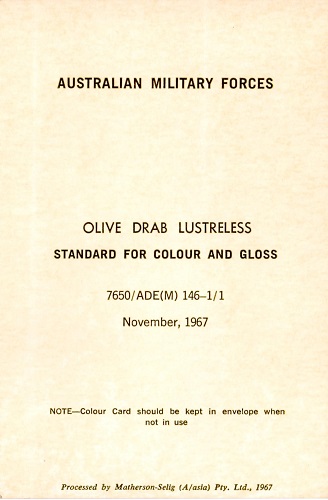 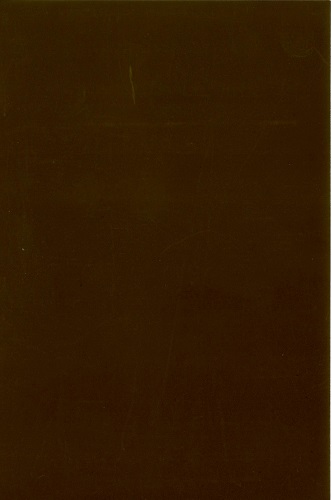
Series 2
and 2a - Final Camouflage
Only a small number of Series 2 and
2a land rovers were still in service when camouflage paint
schemes began taking over from olive drab.
Some of these vehicles even started off in deep bronze green.
These vehicles were mainly specialist vehicles like
ambulances, workshop vehicles and gunbuggies. The scheme that
they used was the same pattern that was applied to the
series 3 fleet when they were painted in camouflage.
Series
3 - Olive Drab
In 1977 the first Series 3
Land-Rover variants began work in the Army. The series 3 fleet
all came from the factory sporting olive drab paint. It
appears at some point the paint type or colour was changes as
factory production notes 2 different colours. Those colours
are Olive Drab, and Semi-Gloss Olive Drab. Most likely it was
simply a change in the way the colour was described.
Initially the rear cross member, jerry can holders
and fuel tank were all the same black as the chassis, as were
the lifting points bolted to the front bumper. The bumper itself
was unpainted galvanised, and the brush bar was painted olive
drab. The wheel nuts and hubs were also black initially. The
galvanised body cappings were unpainted as well.
Some series 3 units appear to have received the
white visibility markings on the jerry can holders and the front
bumper like the series 2 and 2a units. The bumpers in this case
appear to have been painted from the lifting points, outwards.
The plastic grille of the series 3 also appears to have received
differing attention. Some have been left in the plain grey of
the plastic, others have been painted olive drab, others black,
and on some camouflaged units, the grill was painted as per the
camouflage pattern.
However front line
units began painting the Series 3 units in a camouflage scheme
some time in the late 1980's. A couple of different schemes
were trailed until a final scheme was settled upon.
The paint is still available from Protec as an
enamel. It's called camouflage green and it's stock number is
342-1166


The front of a series 3 with the bumper still in plain
galvanised, rather than painted and the recovery points
in black. The white stripe that can be seen on the
recovery point is to show that a modification had been
done to strengthen the bumper mounting on the chassis. |


A rear view of a series 3, again with the originally
black rear cross member. and red reflectors. |


Later on the front bumpers of the series 3 ended up
painted |
|
Series 3 - Interim Camouflage schemes
Experiments at the unit level with cam paint schemes lead up
to Auscam's approval as the fleet scheme. Cam schemes first
appeared on Australian Army vehicles (including Land-Rovers)
attached to the Armour Corps and the Infantry Corps (Heavy
Weapons Platoon Gunbuggys and the Special Air Service LRPVs)
in the 1980's. The schemes were not uniform and reflected unit
level preferences. Some different
schemes appear to be more wide spread than others.
Series 3 -
Final Camouflage Scheme
Series 3 units still in
service in the late 1980's at this time also received the
Auscam scheme, as did any series 2 or 2A specialist vehicles
still in service (Such as workshop vehicles and ambulances).
This camouflage scheme used olive drab, black and tan in a
set pattern. The olive drab was the base colour of the
vehicle and the other 2 colours were applied over the top.
Painting of vehicles started at front line units
with some units like schools never repainting their vehicles.
Not all series 3 land rovers received the camouflage paint
schemes.
The actual pattern applied to vehicles appears to
have been a slightly modified version of what was applied to the
110 Perenties, although a couple of variations appear to have
been used.
The paint in those three satin colours are
still available from Protec and even have their NSN's on the
tin still. It is enamel and quite easy to paint with.
- Camouflage green (342-1166)
- Camouflage tan (342-5265)
- Camouflage black (342-7165)
101 Forward Control
The 101 was used around
the same period of time that the Series 3 was in use with
the Australian Army. As such it was painted in the same
olive drab paint that the series 3 was.
110 Perentie -
Auscam DP Camouflage
When the Perentie 110 models were manufactured from 1987 they
were also factory painted that same Olive Drab colour, though
the paint itself was technically much improved. However not
long after production began the painting switched from plain
olive drab, to the Dispersal Pattern Camouflage (DPC) more commonly known as Auscam. The vehicles
that participated in project Perentie were all in olive drab,
photos of those vehicles can be seen on the Project Perentie page.
At sometime before the new SASR 6x6 LRPVs were
delivered to the Army, the Auscam became the official scheme. It
has gradually (over the 1990's decade) been applied to the whole
"green" fleet, from Mack 6x6 Dumpers to the ½ ton trailer. This
approved "disruptive pattern" paint scheme ("Auscam") was
factory painted on the batch of the Land-Rover TD5 110s in the
year 2000 indicating it is still the current scheme. This big
fleet colour changeover job was still in progress at some
Australian Army Reserve depots as late as 2001. It seems
vehicles were repainted as the opportunity eventuated or when
the vehicle's original Olive Drab paint had faded and thinned
out to the point where it started to look neglected and in need
of TLC. Vehicles which were rebuilt or had major repairs
undertaken were also repainted.
So to sum up, the colours you need from protec
for the current 3 colour paint scheme are:
- camouflage green - 342-1166
- camouflage tan (brown) - 342-5265
- camouflage black - 342-7165

110
Perentie - NORFORCE
For the Norforce/SASR enthusiasts who want their vehicle to look
like a RFSV the three colours you need are:
- Camouflage Green - 342-1166
- Camouflage Pilbara Brown - 342-5239
- Camouflage Brown (Auscam Tan) - 342-5265
110
Perentie - Desert
And for the current Iraq/Afghanistan scheme:
- Camouflage Brown (Auscam Tan) - 342-5265
- Camouflage Light Tan - 342-5726
110
Perentie - Stick On
Sometimes you need more than just paint in a tactical situation, and the SRV and RFSV variants are the ones that head bush more than any other. Some stick on camouflage was developed to allow patches of camouflage netting and matts to be added to a vehicle to help break up their shape, surface etc. This was attached by the use of velcro of all things, with strips being attached to the vehicle and to the back of the camouflage sheets. Certainly the velcro left behind (or the marks for them) is a givaway that the vehicle has had it applied at some stage. The below photos of a SRV taken by Glenn Smith show the patches applied, and the velcro used to attach it.
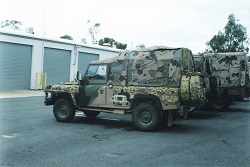 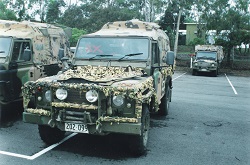 
United Nations Service
At varying times the Australian Army
has deployed vehicles overseas to support United Nations
actions. These vehicles have been painted in over all white
with UN in large black letters usually written on the doors.
Many 4x4 and 6x6 110 Perenties have been deployed, but some
Series 3 and Series 2a vehicles have also been deployed. In
some cases vehicles were painted white in readiness for a
deployment, and put in storage, but then never used. One REMLR
member has one such vehicle, a series 2a ambulance converted
to a workshop in the back. The Army Museum Bandiana has
another ambulance also painted white for deployment. It is not
thought either vehicles were sent overseas, as by the time the
deployment occurred, the Land Rover 6x6 Ambulances had
replaced them. One Series 2a workshop that is known to have
been deployed is now on display at the Australian War
Memorial. It is difficult to know which these vehicles were
because photos of these vehicles overseas normally show the
vehicles wearing united nations number plates.
For more information on UN deployments, visit the REMLR UN Deployment
page.
UN deployments that vehicles may have been
sent to include:
UN Transition Assistance Group in Namibia
(UNTAG), April 1989 - March 1990;
The Australian Contingent to the UN Advance Mission in
Cambodia (UNAMIC), Oct 1991 - May 1992;
The Australian Contingent to the UN Transitional Authority in
Cambodia (UNTAC), May 1992 - Nov 1993;
The Second UN Operation in Somalia (UNOSOM II), May 1993 - Mar
1995;
The Australian Contingent to the Second UN Assistance Mission
in Rwanda (UNAMIR II), May 1994 - May 1995;
International Force, East Timor (INTERFET), Sep 1999 - Feb
2000;
UN Transitional Administration in East Timor (UNTAET), Feb
2000 - May 2002;
UN Mission In Support of East Timor (UNMISET), May 2002 - Aug
2003;
For more information on UN deployments visit http://www.peacekeepers.asn.au/
Trailers
Trailers in the Australian Army have always
been painted in plain olive drab. Only some of the very early
trailers were painted in Deep Bronze Green. Later in the
1980's the trailer fleet began being painted in the camouflage
scheme and newer trailers came from the factory in the
camouflage scheme. The approved camouflage pattern is
illustrated below.
Trial, Temporary and Experimental Camouflage
Schemes
During the years before the official
introduction of a set camouflage scheme in the 1990's, many
units trailed camouflage paint schemes on their vehicles on a
temporary and permanent basis. Early experiments were mainly
black shapes painted over the olive drab, but as the years
went by three and four colour schemes appeared before the
national standardisation. This was not limited to land rovers,
although these were the most prolific vehicles in the GS
fleet.
There are always exceptions however. For example,
the LRPV's used by the SASR wore camouflage schemes almost from
day one!


Photo: Mark Thomas |


One for the Inter Guys, F1 bogged, I think High Range
Training Area from memory? Note local unit applied cam
paint job. We painted things like this when we ran out of
rocks to paint (no I am not joking)
Photo: Mark Thomas |


Photo: Mark Thomas |


Photo: Mark Thomas |

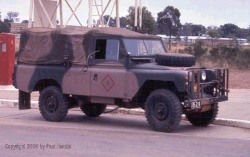
Another example of the black on olive drab approach.
Painting the canopy does not help it's life span! |
|
Some vehicles that stayed in service a long time
such as workshop land rovers appear to have been painted in the
tan, black and green colour scheme commonly called auscam
I have also included 4 scans from slides I have of
M113's with different types of patterns for trials. I believe to
be circa late 70's early 80's but defiantly prior to 1985 and I
believe at 1 Brg Holsworthy. (Thanks to Phil L for the
information and images)

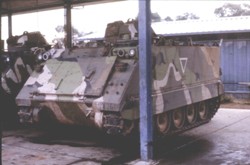
A multi colour scheme on an M113. |

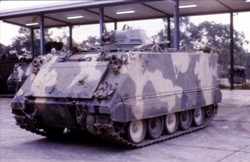
A different 3 tone scheme on another M113. |

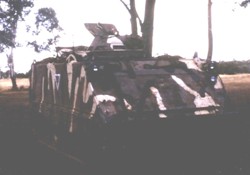
An almost tiger stripe scheme on another M113 with paler
colours. |

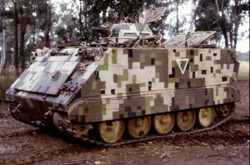
What is now known as digital camouflage on a fourth
M113. This is used on the unimog and land rover 110
canopies. |
3 Brg ODF Townsville
Back in 1981 the entire vehicle fleet
of the 3rd Brg Operational Deployment Force (ODF) Townsville
were cammed. Maybe it's due to it relative isolation from the
the main part of Australia and that the vehicles rarely ventured
south of Rockhampton Qld. The vehicles were all painted prior to
the "Kangaroo 81" exercise. The scheme was a 3 colour black,
stone, olive drab base. The canvas work was also spray painted.
A note with that was they did not put a flex additive in to the
paint prior to painting the canvas and all the canvases wore out
prematurely and all had to be replaced not long into the new
year. 3rd division was the ODF so was always on standby for
action.
The brigade then stuck with having camo vehicles.
The rest of the army took years before it became wide spread and
then finally across the board (Thanks to Phil L for the
information and images)
In April 2014, WO2 Rocky Hema from the 3rd / 4th Cavalry Regiment Museum in Townsville provided us with some more photos and information about these unusually painted vehicles and some timeline information.
I have included some photos of the first batch of cam painted vehicles we did mid 1981, prior to exercise Kangaroo 81. The 3rd Task Force (as it was known then) Commander, Neville Smedhurst, directed 102 Field Workshops to paint everything cam (including weapons).
The selected colours for vehicles overlaid on the base olive drab were:
Flat Green (similar to the Huey helicopter green), Sand and Black.
This first scheme lasted till it was changed in Jan 1983 to the: Pink,
Brown and Tan
The reason for the change was to align the now 3rd Brigade with our area of operations moreso, being the northern part of Australia. Everyone turned their noses up when the vehicles were painted these colours; however, as the paint started to fade, it became very effective to the extent that its worked well during Exercise K83 in the Pilbara. This scheme remained here in Townsville for some time until the new fleet of Landrovers arrived with the current cam pattern. Then everything was painted the traditional cam scheme.
I was part of the preparation team for both occasions, masking and removing items prior to painting. This was a Task Force directed affair, so everyone who could paint was seconded for this job. It was a pain when southern units joined in on some exercises as they wanted their equipment painted. The only trouble was, 102 FD WKSP had to return the vehicles back to base colour prior to them departing Townsville. I guess this is what drove the purpose of standardising the fleet to a particular cam scheme.

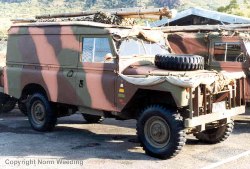
This appears to be the camouflage scheme used by 3rd
brig on a Series 2a panel van.
Copyright: Paul Handel |

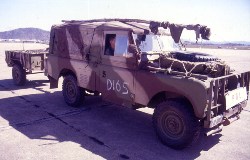
A Series 3 FFR in the same scheme, photographed at the
same time as the workshop vehicle lower down this
section. |

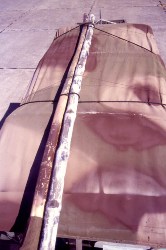
The canopy even carries the complete camouflage pattern! |


Series 3 FFR and No.5 trailer together. |


Series3 FFR. |


Series3 FFR. |


Series3 FFR. |


Series3 FFR. |


Series3 FFR. |

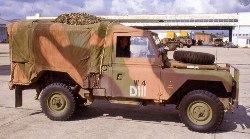
Two views of a Series 2A workshop vehicle in the same
scheme. |

 |


painting tents in action.
Copyright
Rocky Hema |


Series 2a Workshop and trailer
Copyright
Rocky Hema |


M816 Recovery Truck
Copyright
Rocky Hema |


Painted vehicles lined up
Copyright
Rocky Hema |
This section is for those unknowns. Vehicles that
have appeared after their army life in unusual paint schemes
that are of unknown or unconfirmed origin. These could be trials
schemes, or no more than the over active paintbrush of a
civilian painter.

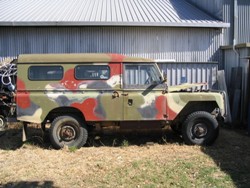
This scheme is an unknown, but as it was in WA it could
have been from the pilbra regiment which use a similar
scheme.
Photo: Stuart Kirkham |


Another mystery camouflage scheme, fact or fiction? |
Some original paint codes
These paint codes are from old manuals or
instructions and do not necessarily reflect available products.
- 8010-66-027-1612: Paint, olive drab, full gloss automotive
enamel, "Wattyl" old code 516-71087 deleted production - in
stock.
- 8010-66-025-5002: Paint, olive drab, lustreless automotive
enamel, "Wattyl" stock code 151603.001 (1 litre) 151603.004
(4 litre can), "Wattyl" old code 516-31088-741382 deleted
production - in stock.
- Paint, "Universal Flattening Base" UFB333, suit above,
"Wattyl" stock code 214117.001
- Paint, "Anzol Polyurathane 450-2022" Olive Drab, suit ADF
Perentie pre-Auscam
Two Pack Paint Codes for Auscam Paint
Scheme from ANZOL (Land Rover Perentie)
ANZOL (Victoria) Pty Ltd
20 Hallam Valley Road, Dandenong
phone 03 97916344 (Graeme Cullen)
- Olive Drab 450-2022 (4 litre tin)
- Matt Black 450-0009 (4 litre tin)
- Tan 450-4058 (4 litre tin)
- Cureing agent 455-9001 (litre tin) (req 2 to 1 mix)
- Thinners 925-0029 (4 litre tin)
thanks Robert (member 035)
Wattyl
As per above, the original supplier
of olive Drab, and possibly Deep Bronze Green appears to
have been Wattyl. Whilst
originally a gloss paint and flattener, as paint technology
evolved, we expect the paint did as well, moving to an all in
one paint like Protec sell.
These paint codes were:
- 516-71087 - Paint, olive drab, full
gloss automotive enamel, "Wattyl" old code deleted
production (NSN 8010-66-027-1612)
- 151603.001 - Paint, olive drab,
lustreless automotive enamel (1 litre) (NSN
8010-66-025-5002)
- 151603.04 - Paint, olive drab, lustreless
automotive enamel (4 litre can)
(NSN 8010-66-025-5002)
Up until late 2010 it was thought that Olive Drab
was no longer available, however REMLR member Diana Allen
provided us with the information, and photos that prove
otherwise! This information is for a 20L tin, but we presume
smaller volumes would also be available. Of note is that it is
the same part number as the automotive paint above, but with the
.20 for 20L instead of .04 for 4 litres, and in the industrial
range, not automotive.
- 151603.20 is the paint code, 8010/660255003 is
the part number, which broken down is also it's NSN of
8101-66-025-5003
- 151603.20 - Lustreless Enamel Olive Drab.
Wattyl Industrial Coating, 20L

Protec PTY LTD
At some point around 2000 ANZOL (the
original paint supplier) was sold to an American company, and
as a result when the contract was up for renewal. The
Department of Defence awarded the contract to PROTEC PTY LTD
which is a South Australian based company. This has many
benefits as their are suppliers in most states and the paint
is an Enamel making it easy to use. The paint is a standard
colour, so if the store does not have the correct colour, it
can simply be ordered in. It is available to anybody, and the
Camouflage green is the correct colour for all green vehicles
post 1967, and is the same colour used
in the Auscam scheme. The paint however is in the protective,
not automotive range of paints.
Below is an excerpt from the paint's
description.
342 CAMOUFLAGE ENAMEL is a low gloss (lusterless), heat
and petrol resistant alkyd finishing enamel with specified
infrared reflectance (IRR) disruptive pattern (DPP)
system.
Approved to APAS – 0165/1
PROTEC PTY. LTD.
Head office: 97-105 Bedford St, Gillman, S.A. 5013
Tel: 08 8447 6311 -- Fax: 08 5447 6692
Available in 20L, 4L, 1L containers.
COLOURS: (prices are for 4 litre
quantities, as at late 2008)(We understand a price increase
occurred in late 2010 as well)
- 342-1166 - Camouflage Green ------$49.91
+GST
- 342-5265 - Camouflage Tan (Brown)
------$44.37 +GST
- 342-7165 - Camouflage Black -------$44.37
+GST
- 342-5726 - Camouflage Light Tan
|





































































